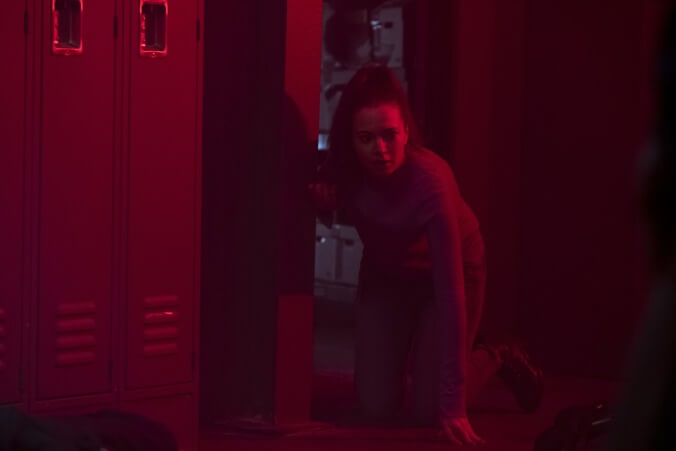James Wan returns to the funhouse with the nutty, gnarly Malignant
The Conjuring conjurer adds some giallo lunacy (and gore!) to his winning fright formula

James Wan is a conductor of fear, and in more ways than one. Watch Insidious or The Conjuring, and it’s easy to picture the director standing in front of the screen as though it were an orchestra, baton in hand—guiding the stings of staccato violin, yes, but also the general rise and fall of tension, and maybe the predatory movements of the camera as it slinks around corners and races into petrified close-ups. It’s perhaps equally easy, however, to imagine Wan planted coaster-side, pulling a lever to lurch a few cars of screaming teens up a steep, rickety track. He makes music from the lowly jump scare, and turns multiplexes into funhouses, like a William Castle for the age of digital phantoms. He conducts horror. By either definition, that takes some chops.
Wan’s new movie, Malignant, is more ride than symphony. But it’s a ride to remember. The film returns its director to his original genre wheelhouse after a stint in the CGI waters of comic-book cinema. The opening frames make that lurch back onto land literal, as we skim the surface of a choppy sea to find a surely haunted hospital looming on the cliffside above like a Transylvanian manor. Over the two hours that follow, Wan will riffle through his bag of tricks with a renewed sense of diabolical purpose: zooming through peepholes, leering from the inside of washing machines, ripping down hallways, pushing invasively into the pale faces of his actors. When a gust of wind blows back the curtain of an open window, revealing the towering specter it was previously concealing, you can almost see the superimposed skeleton grin of the director, cackling through his rudimentary but expertly timed gag.
Inside that medical facility, glimpsed in violent prologue and returned to for expository purposes later, lurks a croaking phantom—a poltergeist with the knifing habits of Jason Voorhees, the limberness of Ray Park, and the phone records of a serial killer taunting the authorities. A couple decades after making mincemeat of some orderlies, the shadow-cloaked “Gabriel” has reemerged to start hacking and slashing again. (He’s like Wan himself, amped to be back in the mayhem business.) The ghoul’s killing spree begins in the home of one Madison Mitchell, who loses her unborn child—the latest in a line of miscarriages—along with her abusive husband in the attack. From there, she’ll be sucked into a sleep-paralysis psychic bond with the killer, her consciousness forced to helplessly witness each of the brutal slayings that follow.
Poor, trembling Madison is played by Annabelle Wallis, who previously evaded another of Wan’s malevolent playthings, the possessed doll who shared her first name. She telegraphs what any savvy viewer will intuit immediately: that beauty and the beast have a history. Could it have something to do with Madison’s true family background? Or that horror-movie habit kids have of making not-actually-so-imaginary friends? For a while, Malignant seems just a inch left of Blumhouse boilerplate in the story department. The supporting characters have all the dimension of Halloween decorations: the stock skeptical detectives; the nerdy CSI agent who’s like a distaff relative of those annoying comic-relief Insidious sidekicks; Madison’s devoted actress sister (Maddie Hasson, who bears a distractingly uncanny resemblance to Florence Pugh). We think, for a while at least, that we’ve inhaled the musty air of this crypt before.
But Malignant has surprises up its sleeve. It gets nuttier and gnarlier as it goes, the script weaponizing an audience’s assumed familiarity with the haunted-house tropes Wan helped re-popularize. Our reward for the healthy helpings of backstory, delivered via long scenes of characters watching grainy VHS tapes, is a fiendish reveal that shifts the movie’s lunacy up several notches. Malignant does more than redirect talents squandered on green screens painted wavy blue in post-production. It also liberates Wan from the Sunday school of his more elegant Conjurings. This is not a movie with any pretensions of Catholic seriousness. It’s more unhinged in its tactics, pulling the filmmaker out of Amityville horror and reconnecting him with his bone-piercing-skin roots as Jigsaw’s daddy. There’s a touch of giallo in the red of the lighting and arterial spray, and in the stilted investigative dialogue of the cops on the case. And the film moves to the forefront the Sam Raimi influence that’s lurked like a repressed memory in the echoey halls of Wan’s style. What is his endlessly ambulatory camera, after all, but a less caffeinated version of that demonic POV ripping at warp speed around The Evil Dead’s neck of the woods?
Regardless of one’s math on the ratio of fun to dumb in Aquaman, there’s no way to watch this deranged follow-up and not conclude that Wan’s back where he belongs. Still, a little of that time in the superhero trenches seems to have crept into his supernatural comeback. Malignant is a zany psychodramatic creepfest that, here and there, veers into gory action hilarity, as though Pazuzu had taken over the body of a Batman movie. Around the midway mark, one of those archetypal sleuths bolts after his parkouring demon perp—a chase that leads down a treacherous fire escape and into a warehouse space, where the cop runs right into… a carriage like the one that took Harker to the Count. The best rides make some unexpected turns on the way to the next drop.